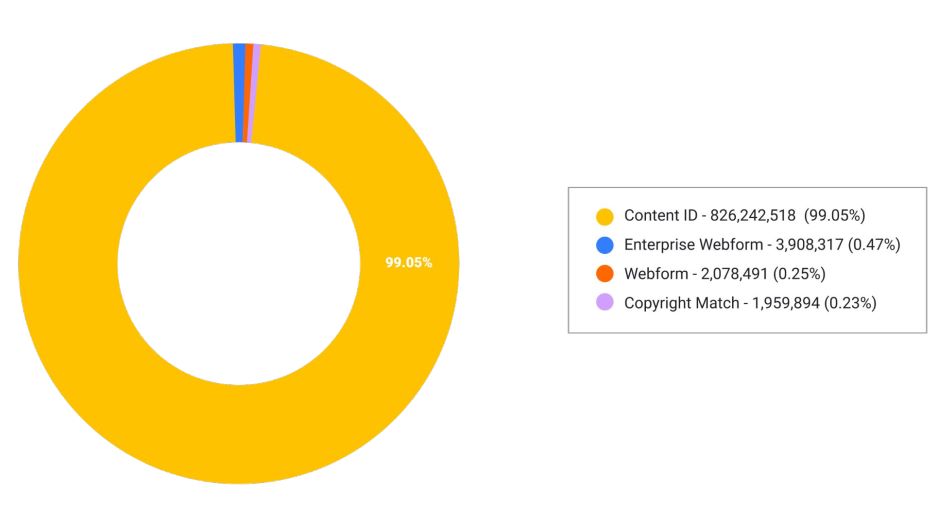To protect copyright holders, YouTube regularly removes, disables, or demonetizes videos that allegedly contain infringing content.
While anyone can send a DMCA notice to the platform, most copyright actions come from the Content ID system that can only be used by a select group of copyright holders.
For many years the number of claims rightsholders made on YouTube was unknown. That changed two years ago when the video platform launched its first-ever transparency report. Since then, the number of claims has steadily continued to rise.
826 Million
YouTube’s latest transparency report reveals that during the second half of last year, rightsholders claimed more than 826 million videos on YouTube. This is the highest figure since YouTube started reporting these figures and a 9% uplift over the same period last year when 759 million videos were flagged.

This increase in claims happened even though fewer copyright holders actively used the Content ID system. Entities utilizing the system dropped from 4,840 in the second half of 2021 to 4,646 during the same period last year.
Applying some basic math to these figures reveals that copyright holders who actively used Content ID claimed over 177,000 videos on average over the six-month period.
Money Machine
While rightsholders are typically unhappy when people use their content without permission, YouTube has managed to reframe this problem as an opportunity. Instead of using the Content ID system to take videos offline, there’s also an option to monetize them instead.
The concept of ‘monetizing’ piracy initially sounded a bit odd but the system has transformed into a healthy revenue stream opportunity. During the most recent reporting period, rightsholders chose to monetize over 90% of all Content ID claims.
This positive take on tackling infringement seems to be quite profitable as well. During 2022, copyright holders were paid around $1.5 billion as a direct result of their Content ID claims. Since the Content ID system was launched several years ago, $9 billion in ‘claimed’ revenue was paid out to copyright holders.
Million Dollar Abuse
The revenue opportunities also come with a downside – scammers. In one recent case, two men set up a company to find and claim unmonetized music. Through a third-party partner with access to the Content ID system, the pair generated over $24 million in revenue from YouTube by falsely claiming ownership.
The abuse didn’t go unnoticed and the repercussions were severe. In 2020, the U.S. Department of Justice indicted the duo and last week the first defendant was sentenced to more than five years in prison.
Intentional abuse schemes of this magnitude are relatively rare for Copyright ID claims. Across YouTube’s broader set of copyright tools, we see that YouTube regularly takes action against abusers.
“We take abuse of our tools seriously — we terminate tens of thousands of accounts each year that attempt to abuse our copyright tools,” the company explains.
In addition to money-driven schemes, copyright takedown abuse can also have a political or competitive angle.
“Sometimes this takes the form of political actors attempting to censor political speech or companies stifling criticism of their products or practices. Other times individuals try to use our copyright processes to bully other creators or to remove videos they see as competing for the same audience.”
99.5% Automated
Aside from intentional abuse, errors can also be triggered by automation. Nearly all Content ID claims (99.5%) are processed automatically through fingerprinting technology. In these cases, potentially-infringing content is flagged by technology with limited human oversight.

Automation saves YouTube and rightsholders a lot of resources but can also be a potential source of abuse and errors. This is one of the reasons why just a small group of verified and responsible rightsholders can join the program.
Despite this hurdle, mistakes happen. YouTube specifically highlights an example where videos of the historic landing of NASA’s Curiosity on Mars were taken down globally. A TV company claimed the public domain footage as their own.
“In Content ID the impact is multiplied due to its automated nature; one bad reference file can impact hundreds or even thousands of videos across the site.
“In one highly publicized instance, a news channel uploaded public domain footage from NASA of a Mars rover and ended up making inappropriate claims against all other news channels and creators using the same footage, even against the NASA channel itself.”
These mistakes are not caused by the automated processes themselves but are triggered when bad reference files are added to the Content ID database.
YouTube notes that on the whole, manual Content ID claims are more than twice as likely to be disputed than automated ones (0.94% vs. 0.43%). Since there are 200 times more automated claims, these still account for the bulk of all disputes.
—-
A copy of YouTube’s latest transparency report, covering the second half of 2022, is available here (pdf)
From: TF, for the latest news on copyright battles, piracy and more.










